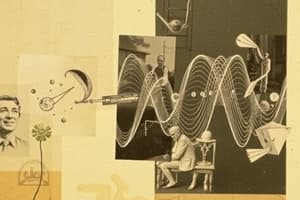Podcast
Questions and Answers
What is required for sound to travel?
What is required for sound to travel?
- Vacuum
- Solid, liquid, or gas medium (correct)
- Magnetism
- Plasma
Which part of the human body vibrates to produce sound?
Which part of the human body vibrates to produce sound?
- Teeth
- Knees
- Vocal cords (correct)
- Fingernails
What happens in sound waves at compressions?
What happens in sound waves at compressions?
- High pressure and density (correct)
- No change in pressure or density
- Low pressure and density
- Compression does not exist in sound waves
Which part of the ear is filled with fluid and sends electrical signals to the brain?
Which part of the ear is filled with fluid and sends electrical signals to the brain?
What is amplitude related to in sound waves?
What is amplitude related to in sound waves?
What is the main factor that determines the loudness of a sound?
What is the main factor that determines the loudness of a sound?
In which part of the human ear is the cochlea located?
In which part of the human ear is the cochlea located?
Why can't sound travel in a vacuum?
Why can't sound travel in a vacuum?
What is the function of the auditory nerve in the ear?
What is the function of the auditory nerve in the ear?
Flashcards are hidden until you start studying
Study Notes
- The chapter is about understanding the characteristics of sound, specifically in Class 8.
- Sound is produced when objects vibrate, such as guitar strings or drum membranes.
- Sound travels as a wave, with compressions and rarefactions in the medium.
- Sound requires a medium to travel, such as solid, liquid, or gas.
- Vocal cords in the voice box vibrate to produce sound in humans.
- Sound cannot travel in a vacuum, as demonstrated in space where there is no medium.
- The ear consists of the outer ear (Pinna), ear canal, eardrum, middle ear bones, cochlea, and auditory nerve.
- The cochlea is a snail-like structure filled with fluid that vibrates and sends electrical signals to the brain.
- Sound wave diagrams are simplified for study purposes, with compressions and rarefactions represented.
- Bose did initial work in studying sound waves for wireless communication.- Compression in sound waves leads to high pressure and density, creating Crests (top points) and Troughs (bottom points).
- A pressure versus distance graph is created to study sound wave characteristics, with Crests representing compressions and Troughs representing rarefactions.
- The distance between two Crests is known as wavelength, while the maximum displacement of a particle from its mean position is called amplitude.
- Loudness is related to amplitude, where louder sounds have higher amplitudes, resulting in a louder sound.
- Frequency is the number of waves produced in one second, with frequency being inversely related to the time period.
- Dogs can hear frequencies beyond human range, making them sensitive to ultrasonic sounds like dog whistles.
- Noise is characterized by unpleasant sounds, while music is associated with pleasant sounds based on personal perception.
- Loud sounds can lead to ear damage by causing excessive vibration of the eardrums, potentially resulting in issues like headaches and sleeplessness.
- Measures to reduce noise pollution include minimizing the use of loudspeakers, avoiding unnecessary honking, and using soundproofing materials.
- Planting more trees can also help in reducing noise pollution by absorbing sound waves.
Studying That Suits You
Use AI to generate personalized quizzes and flashcards to suit your learning preferences.




